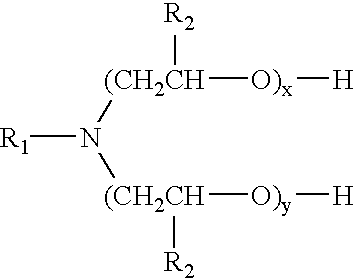Shingle and mat tensile strength with urea formaldehyde resin modifier
a technology of urea formaldehyde and modifier, which is applied in the field of composite sheet materials, can solve the problems of insufficient tensile strength, interruption in roofing manufacture, and inadequate tensile strength, and achieve the effect of increasing the tensile strength of glass fiber mats
- Summary
- Abstract
- Description
- Claims
- Application Information
AI Technical Summary
Benefits of technology
Problems solved by technology
Method used
Image
Examples
example 1
[0027]Glass fibers were randomly dispersed in water to form a dispersion. The dispersion was then strained and the resultant wet glass fibers were disposed on a moving screen. The wet glass fibers on the moving screen were contacted with a urea formaldehyde resin dispersion which included 1% by weight, based on the total weight of the resin binder solids, of ABS copolymer, Hycar® G-17.
[0028]The urea formaldehyde coated glass fibers were heated in an air oven at 300° C. at atmospheric pressure for 13 seconds. The resultant product, a urea formaldehyde cured glass fiber mat, was thereupon coated with an unfilled asphalt coating.
[0029]Eight samples of the coated product were tested for tensile strength. The tensile strength was obtained by employing a constant rate of elongation machine. That machine, a product of the Instron Corporation, processed test specimens 1″ wide by 4″ long. The test was conducted at a constant rate of 1-inch elongation per minute. The tensile strength reported...
example 2
[0033]Example 1 was repeated but for the concentration of the ABS modifier employed in the manufacture of the composite sheets of urea formaldehyde reinforced by glass fibers. In this example the urea formaldehyde was modified by 10% by weight, based on the total weight of the resin binder solids, of Hycar® G-17. The percentage was by weight based on the weight of the urea formaldehyde binder.
[0034]The tensile strength of the ply sheets is reported in Table 1.
[0035]This test is compared to those conducted on samples prepared under the same conditions but for the replacement of the ABS copolymer with a conventional urea formaldehyde modifier styrene butadiene rubber (SBR). The results of this test are summarized in Table 2.
example 3
[0036]Example 2 was duplicated but for the concentration of the ABS Hycar® G-17 modifier. In this example the ABS was present in a concentration of 20% by weight, based on the weight of the urea formaldehyde binder.
[0037]The results of Example 3 are reported in the Table 1.
[0038]These tests are compared to those conducted on samples prepared under the same conditions but for the replacement of the ABS copolymer with a conventional urea formaldehyde modified with styrene butadiene rubber (SBR) latex. The results of this test are summarized in Table 2.
[0039]
TABLE 1Tensile Strength,lbf / in2 ± StandardDeviation,.Example No.ABS Modifier, %lbf / in2112054 ± 3052102596 ± 3493202636 ± 321
[0040]
TABLE 2Tensile Strength, ±Example No.SBR Modifier, %Standard Deviation111720 + 2652102444 + 2263202601 + 399
PUM
| Property | Measurement | Unit |
|---|---|---|
| temperature | aaaaa | aaaaa |
| temperature | aaaaa | aaaaa |
| weight % | aaaaa | aaaaa |
Abstract
Description
Claims
Application Information
 Login to View More
Login to View More - R&D
- Intellectual Property
- Life Sciences
- Materials
- Tech Scout
- Unparalleled Data Quality
- Higher Quality Content
- 60% Fewer Hallucinations
Browse by: Latest US Patents, China's latest patents, Technical Efficacy Thesaurus, Application Domain, Technology Topic, Popular Technical Reports.
© 2025 PatSnap. All rights reserved.Legal|Privacy policy|Modern Slavery Act Transparency Statement|Sitemap|About US| Contact US: help@patsnap.com

